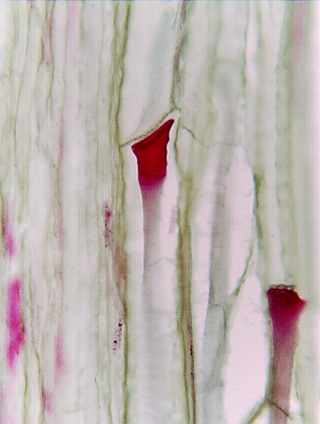 Fig.
8.3-1. Longitudinal section of sieve tube members in stem of cucumber
(Cucumis). This material was fixed in such a way as to enhance the
formation of P-protein
plugs, two of which are present here, stained red. When phloem is cut
or chewed into, the release of pressure causes the P-protein to surge toward the
sieve plate, where it becomes entangled. The plug is always on the side of the
sieve plate opposite the damage: the first dissection cut in this sample -- the
one that damaged the phloem -- was made above the top of the micrograph, not
below the bottom. The plugs are widest at the sieve plate itself, and then are
narrower farther away from the plate. Only the portion of the plug that is close
to the plate has stained intensely.
Fig.
8.3-1. Longitudinal section of sieve tube members in stem of cucumber
(Cucumis). This material was fixed in such a way as to enhance the
formation of P-protein
plugs, two of which are present here, stained red. When phloem is cut
or chewed into, the release of pressure causes the P-protein to surge toward the
sieve plate, where it becomes entangled. The plug is always on the side of the
sieve plate opposite the damage: the first dissection cut in this sample -- the
one that damaged the phloem -- was made above the top of the micrograph, not
below the bottom. The plugs are widest at the sieve plate itself, and then are
narrower farther away from the plate. Only the portion of the plug that is close
to the plate has stained intensely.